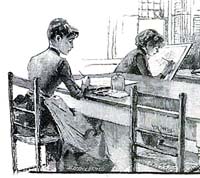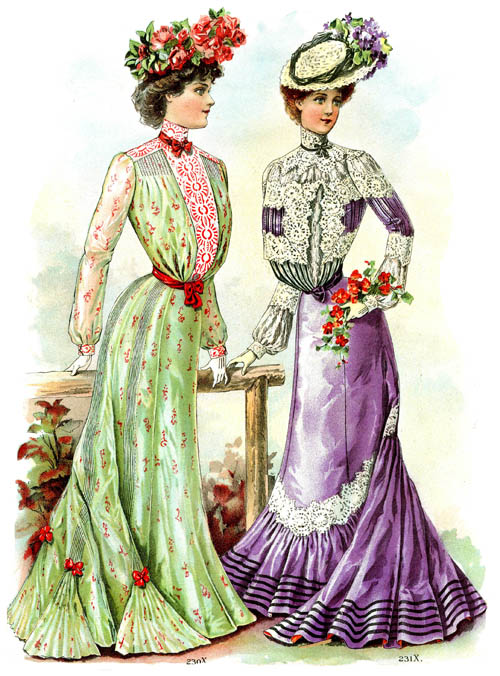|
Home > The Victorian Woman > Women at Work > Women's Working Conditions

|
One of the concerns about women entering the work force was the negative moral effect it might have upon their lives. Many organizations and institutes were set up to help working women combat the evil moral influences that surrounded them... This section looks at working conditions on the job, and at the lives of working women after hours.
|
- Life in England
(Godey's, 1867)
- A look at the miserable working lives of women and children in the Spitalfields silk trade.
- The Saturday Half-Holiday
(Leisure Hour, 1868)
- On the new system of ending the working week at the dinner-hour (midday) on Saturdays. Does it pay? It appears that, by giving "the men" more opportunity to revitalize their health and spirits, they work harder the rest of the week, so the system benefits everyone.
- Some Habits and Customs of the Working Classes
(Leisure Hour, 1868)
- A review and summary of a book by that title.
- The Outdoor Business Girls of London
(Cassell's Family Magazine, 1877)
- "Sin, misery, destruction are the too frequent result of the awful liberty, the terrible freedom, the young, inexperienced out-door business girl possesses."
- A Contrast
(Girl's Own Paper, 1880)
- A parable on the working conditions of dressmakers.
- The Standing Evil: A Plea for Shop Girls
(Girl's Own Paper, 1880)
- An intriguing article suggesting a form of "standing seat" to ease the strain upon shop girls.
- The Working Girls of London
(Girl's Own Paper, 1880)
- An appeal to help establish homes for the working girls of London.
- The Way Some Folks Live: A Turn Amongst the Spitalfields Weavers, by A.R. Buckland
(Cassell's Family Magazine, 1883)
- Tips and Their Takers
(Century Magazine, 1884B)
- An argument against the practice of tipping as being a custom that divides the social classes (tipper vs. tippee). Warning - not politically correct.
- Girls of the Ballet and Chorus, by Anne Beale
(Girl's Own Paper, 1885)
- Explores some of the difficulties faced by women who work or have worked upon the stage.
- "Called to the Bar," by Anne Beale
(Girl's Own Paper, 1886)
- A look at the working conditions of the "thousands" of young woman who work in London's restaurants and railway bars.
- The Eight-Hour Working Day
(Century Magazine, 1887A)
- On the proposal to reduce the working day to eight hours.
- Healthy Lives for Working Girls
(Girl's Own Paper, 1887)
- How Working Girls Live in London, by Nanette Mason
(Girl's Own Paper, 1889)
- "To them the first city in the world is a place of hard work, little pay, and still less enjoyment. Victims of pitiless and incessant competition, they are struggling through life with small pleasure in the past and with but little hope for the future." This fascinating article looks at girls' wages, statistics, lodgings, opportunities for savings and more.
- Certain Forms of Woman's Work for Women, by Helen Campbell
(Century Magazine, 1889B)
- A look at working conditions and the founding of the YWCA.
- Tipping
(Century Magazine, 1889B)
- Another argument against the practice.
- Competition and Cooperation Among Women, by Mrs. Jeune
(English Illustrated Magazine, 1890A)
- On the struggles of factory and sweatshop women in London.
- Women Behind the Counter, by Ida M. Van Etten (Ladies' Home Journal, 1892)
- Problems besetting shop-girls.
- What Working Girls Say About Sunday, by Ruth Lamb
(Girl's Own Paper, 1893)
- Factory Girls at Work and Play, by Lloyd Lester
(Girl's Own Paper, 1895)
- "These papers...are written with the object of interesting and guiding our sweet girls into the exercise of...tender comprehending sympathy with and for their toiling sisters, the best part of whose youth is spent in dull factories helping to manufacture the thousand and one pretty trifles or useful indispensibles which girls, in more favoured circumstances, only associate with amusement or pleasure."
- A Specimen Factory Girl, by Frances Hicks
(Girl's Own Paper, 1895)
- This girl's life in the factory begins at age 10...
- Barmaids and Waitresses in Restaurants, Their Work and Temptations
(Girl's Own Paper, 1896)
- "...of all occupations undertaken by girls for a living, there is none more difficult and dangerous than that of serving at the "bar," and waiting in restaurants, nor any that calls out less the sympathy of outsiders... One girl said with tears in her eyes, 'The modest, well-behaved ones among us suffer the most; their lives are one long torture.'"
- Our Occupations, by J. Holt Schooling
(Windsor Magazine, 1897B)
- Statistics on employment in the UK.
- Social Incidents in the Life of an East End Girl
(Girl's Own Paper, 1899)
- This look at the life and living conditions of an "East End" girl runs for several installments, but apparently was never concluded.
|
Clubs & Organizations for Working Women
|
- The Girls' Friendly Society
(Girl's Own Paper, 1883)
- Originally organized to assist country girls employed in London.
- The Girls' Own Home, by the Countess of Aberdeen
(Girl's Own Paper, 1883)
- "If [a working girl] has no home to go to, will she not be likely to seek for change from the dreary round of work by reading the trashy literature that abounds, by resorting to dancing-rooms and theatres, where she had better never be seen, where she is in danger of losing all that is pure and true and high-minded, where she may form companionships which will prove fatal to her?" Seven "girls' homes" already existed at this point, and the Countess was encouraging the Girl's Own Paper to found another.
- Hyde House, by Anne Beale
(Girl's Own Paper, 1884)
- A home for working girls.
- Music Among the Working Girls of London, by A.M. Wakefield
(Girl's Own Paper, 1890)
- The "Working Girls Club Union" and its musical programs.
- Women's Clubs in London, by S.F.A. Caulfeild
(Girl's Own Paper, 1890)
- "...we may observe the increase of improvident marriages and those of the physically unsuitable, the many failures of financial enterprises, the deterioration of the value of land... Thus the daughters of the very elite of the untitled aristocracy are driven from home... to become the bread-earners for themselves and their families... an article like this demands such an introduction as showing the origin of the needs-be for women's clubs."
- Sunny Spots for Working Girls, by Grace H. Dodge (Ladies' Home Journal, 1892)
- A look at clubs for American working girls.
- The Story of a London Factory Girls' Club, by Mary Canney
(Girl's Own Paper, 1895)
- Good Cheer for Women Workers
(Girl's Own Paper, 1899)
- "A short sketch of 'Kent House,' the YWCA House for Students and Others" in London.
|
Visit Our Victorian Shop
for:
Books
Coloring Books
Beautiful Spiral Journals
Holiday Greeting Cards
|
|


 Discover thousands of Victorian images in our
Discover thousands of Victorian images in our 